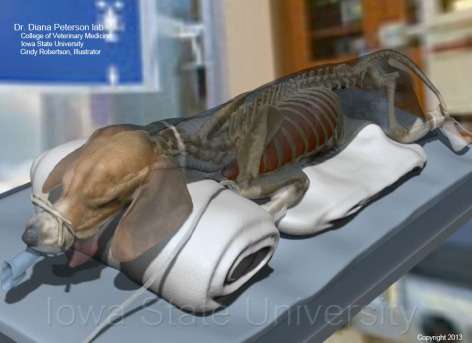Anatomy expert is creating digital models to train surgical students

An anatomy expert at Iowa State University is developing digital tools that could help surgical students gain nearly lifelike experience with a scalpel without having to cut into cadavers or living subjects.
Diana Peterson, an assistant professor of biomedical sciences in ISU's College of Veterinary Medicine, has high hopes for a project that could lead to realistic surgical training in a virtual world. Peterson envisions a three-dimensional virtual reality program that simulates both human and animal anatomy and recreates the surgical experience better than almost any existing training method short of the real thing.
"Eventually, we'd like to create a virtual surgery suite that uses virtual reality glasses and haptic gloves," Peterson said. "You'd basically go into the suite and be the surgeon."
The high-tech surgical suite would combine the virtual world with tactile models that would simulate the body of an animal or human requiring surgery, she said.
The idea began to take shape two years ago while Peterson was teaching an animal anatomy class. Her background is in human anatomy, and she found that the technology used to teach students about the inner workings of the human body far outpaced what was used in veterinary classes.
"In most cases, veterinary students only have textbook-flat diagrams to help them visualize the anatomy of animals," she said. "They don't benefit from the technology that human anatomists have."
So she began working with Stephen Gilbert, an assistant professor of industrial and manufacturing engineering, and Eliot Winer, an associate professor of mechanical engineering, to create highly detailed 3-D digital diagrams using data from CT scans of animals. In addition to a human, the faculty members have put together detailed representations of a beagle and a horse's leg.
Using a computer, the diagrams allow the user to isolate specific structures and systems within the body, such as bones or muscles or blood vessels, and see how they fit together in a three-dimensional space.
Peterson said she's going to use the 3-D models to supplement the traditional 2-D representations in a veterinary anatomy class this fall and track how the students respond. She's begun the process of applying for grants, and, if the project attracts enough funding, she's hoping to have a virtual reality surgery suite up and running within three years.
Existing surgical training programs have utilized digital models, but Peterson said she plans to add a variety of complications to the virtual reality technology. For instance, she said existing programs focus on completing a surgical procedure the correct way. They don't allow students to make mistakes.
Peterson said she wants her program to respond realistically if a student makes a mistake. She is working to create a variety of complications that the surgical trainee would encounter during the surgery that could be either random or controlled by an instructor. The ultimate goal would be to simulate an experience as true to life as possible.
"It's one thing to know on an intellectual level how to perform surgery, but it's another to actually do it," she said. "And the program will let the students mess up and show them what happens when they make a mistake in a realistic way. I don't think this will replace dissection for teaching anatomy, but it can dramatically augment the learning curve."



















